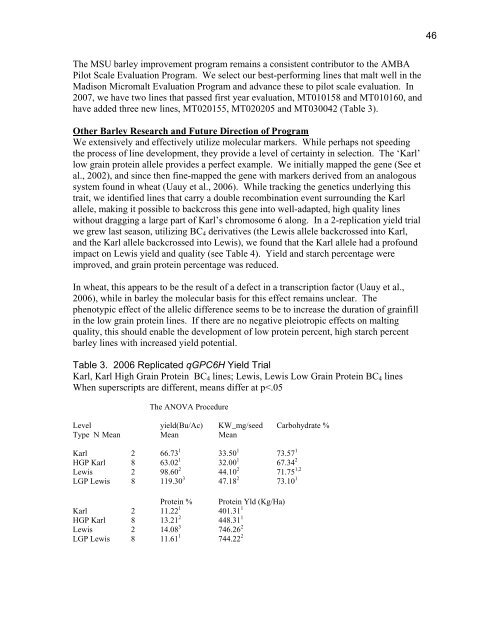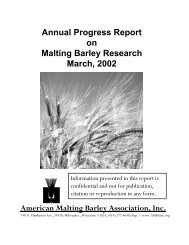Annual Progress Report on Malting Barley Research March, 2007
Annual Progress Report on Malting Barley Research March, 2007
Annual Progress Report on Malting Barley Research March, 2007
You also want an ePaper? Increase the reach of your titles
YUMPU automatically turns print PDFs into web optimized ePapers that Google loves.
The MSU barley improvement program remains a c<strong>on</strong>sistent c<strong>on</strong>tributor to the AMBA<br />
Pilot Scale Evaluati<strong>on</strong> Program. We select our best-performing lines that malt well in the<br />
Madis<strong>on</strong> Micromalt Evaluati<strong>on</strong> Program and advance these to pilot scale evaluati<strong>on</strong>. In<br />
<strong>2007</strong>, we have two lines that passed first year evaluati<strong>on</strong>, MT010158 and MT010160, and<br />
have added three new lines, MT020155, MT020205 and MT030042 (Table 3).<br />
Other <strong>Barley</strong> <strong>Research</strong> and Future Directi<strong>on</strong> of Program<br />
We extensively and effectively utilize molecular markers. While perhaps not speeding<br />
the process of line development, they provide a level of certainty in selecti<strong>on</strong>. The ‘Karl’<br />
low grain protein allele provides a perfect example. We initially mapped the gene (See et<br />
al., 2002), and since then fine-mapped the gene with markers derived from an analogous<br />
system found in wheat (Uauy et al., 2006). While tracking the genetics underlying this<br />
trait, we identified lines that carry a double recombinati<strong>on</strong> event surrounding the Karl<br />
allele, making it possible to backcross this gene into well-adapted, high quality lines<br />
without dragging a large part of Karl’s chromosome 6 al<strong>on</strong>g. In a 2-replicati<strong>on</strong> yield trial<br />
we grew last seas<strong>on</strong>, utilizing BC4 derivatives (the Lewis allele backcrossed into Karl,<br />
and the Karl allele backcrossed into Lewis), we found that the Karl allele had a profound<br />
impact <strong>on</strong> Lewis yield and quality (see Table 4). Yield and starch percentage were<br />
improved, and grain protein percentage was reduced.<br />
In wheat, this appears to be the result of a defect in a transcripti<strong>on</strong> factor (Uauy et al.,<br />
2006), while in barley the molecular basis for this effect remains unclear. The<br />
phenotypic effect of the allelic difference seems to be to increase the durati<strong>on</strong> of grainfill<br />
in the low grain protein lines. If there are no negative pleiotropic effects <strong>on</strong> malting<br />
quality, this should enable the development of low protein percent, high starch percent<br />
barley lines with increased yield potential.<br />
Table 3. 2006 Replicated qGPC6H Yield Trial<br />
Karl, Karl High Grain Protein BC4 lines; Lewis, Lewis Low Grain Protein BC4 lines<br />
When superscripts are different, means differ at p
















